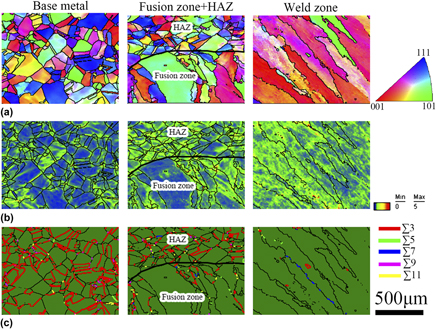Crossref Citations
This article has been cited by the following publications. This list is generated based on data provided by
Crossref.
Sriba, Amina
Vogt, Jean-Bernard
and
Amara, Sif-Eddine
2018.
Microstructure, Micro-hardness and Impact Toughness of Welded Austenitic Stainless Steel 316L.
Transactions of the Indian Institute of Metals,
Vol. 71,
Issue. 9,
p.
2303.
Melia, Michael A.
Nguyen, Hai-Duy A.
Rodelas, Jeffrey M.
and
Schindelholz, Eric J.
2019.
Corrosion properties of 304L stainless steel made by directed energy deposition additive manufacturing.
Corrosion Science,
Vol. 152,
Issue. ,
p.
20.
Kumar, Viranshu
Kumar Gupta, Ratnesh
and
Das, Ghanshyam
2019.
Pitting and Electrochemical corrosion behaviour of 316L austenitic stainless steel subjected to warm deformation.
IOP Conference Series: Materials Science and Engineering,
Vol. 653,
Issue. 1,
p.
012038.
Nunes, Marlon Muniz
Gomes, José Henrique de Freitas
Brito, Tarcisio Gonçalves
and
Renzetti, Reny Angela
2020.
Effect of Flux Cored arc Welding Process Parameters on Corrosion Resistance of Austenitic Stainless Steel Claddings.
Materials Research,
Vol. 23,
Issue. 6,
kumar, Viranshu
Kumar Gupta, Ratnesh
and
Das, Ghanshyam
2020.
Influence of Deformation and Annealing on Microstructure and Corrosion Behavior of Austenitic Stainless Steel.
Materials Today: Proceedings,
Vol. 22,
Issue. ,
p.
3347.
Kumar, Viranshu
Gupta, Ratnesh Kumar
and
Das, Ghanshyam
2020.
Influence of Forging and Annealing on the Microstructure and Corrosion Behavior of Austenitic Stainless Steel.
Journal of The Institution of Engineers (India): Series D,
Vol. 101,
Issue. 1,
p.
105.
Zhang, Zhe
Li, An
Wang, Yanping
Lin, Qiang
and
Chen, Xu
2020.
Low-cycle fatigue behavior and life prediction of fine-grained 316LN austenitic stainless steel.
Journal of Materials Research,
Vol. 35,
Issue. 23-24,
p.
3180.
Kannan, A Rajesh
Shanmugam, N Siva
and
Sreedhar, G
2020.
Studies on corrosion behavior of AISI 316L cold metal transfer weldments in physiological solutions.
Proceedings of the Institution of Mechanical Engineers, Part E: Journal of Process Mechanical Engineering,
Vol. 234,
Issue. 6,
p.
644.
Yang, Ke
Wang, Qiuyu
Qu, Yang
Jiang, Yongfeng
and
Bao, Yefeng
2020.
Microstructure and Corrosion Resistance of Arc Additive Manufactured 316L Stainless Steel.
Journal of Wuhan University of Technology-Mater. Sci. Ed.,
Vol. 35,
Issue. 5,
p.
930.
Kumar, Arun
Singh, Beant
and
Sandhu, Sandeep Singh
2020.
Influence of Thermal Aging on Metallurgical, Mechanical and Corrosion Performance of Electron Beam Welded 18mm Thick AISI 316.
Fusion Engineering and Design,
Vol. 161,
Issue. ,
p.
112092.
Kumar, Viranshu
Gupta, Ratnesh Kumar
and
Das, Ghanshyam
2020.
Effect of Warm Forging on the Microstructure and Corrosion Behavior of Austenitic Stainless Steel 316LN.
Materials Performance and Characterization,
Vol. 9,
Issue. 1,
p.
94.
Kumar, Arun
and
Sandhu, Sandeep Singh
2021.
Effect of Beam Oscillation on Metallurgical and Mechanical Properties of the Electron Beam Welded SS 316 Welded Joints.
Metallography, Microstructure, and Analysis,
Vol. 10,
Issue. 6,
p.
776.
Schindelholz, Eric J.
Melia, Michael A.
and
Rodelas, Jeffrey M.
2021.
Corrosion of Additively Manufactured Stainless Steels—Process, Structure, Performance: A Review.
Corrosion,
Vol. 77,
Issue. 5,
p.
484.
Heo, Jun
Lee, Sang Yoon
Lee, Jaewoo
Alfantazi, Akram
and
Cho, Sung Oh
2021.
Improvement of Corrosion Resistance of Stainless Steel Welded Joint Using a Nanostructured Oxide Layer.
Nanomaterials,
Vol. 11,
Issue. 4,
p.
838.
Barbieri, Giuseppe
Cognini, Francesco
Pilloni, Luciano
Mirabile Gattia, Daniele
and
Testani, Claudio
2021.
15/15 Ti Stainless Steel Welding Process Optimization for GEN IV Nuclear Application in the GEMMA Project Frame.
Materials Science Forum,
Vol. 1016,
Issue. ,
p.
262.
Mannepalli, Srinivas
Shankar, A. R.
Ningshen, S.
and
Philip, John
2022.
Some aspects of pitting corrosion susceptibility of As‐welded and thermally aged nitrogen‐alloyed 316SS weld metal.
Materials and Corrosion,
Vol. 73,
Issue. 6,
p.
851.
Kim, Seunghyun
Kim, Gidong
Oh, Chang-Young
and
Song, Sangwoo
2022.
Pitting and Localized Galvanic Corrosion Characteristics of Gas Tungsten Arc Welded Austenitic Stainless Steel.
Metals and Materials International,
Vol. 28,
Issue. 10,
p.
2448.
Malhotra, Dikshant
and
Shahi, A. S.
2023.
Metallurgical Behavior and Corrosion Performance of Ti + Nb Stabilized Austenitic Stainless Steel Welds.
Journal of Materials Engineering and Performance,
Vol. 32,
Issue. 2,
p.
544.
Kadoi, Kota
Kogure, Mari
and
Inoue, Hiroshige
2023.
Effect of ferrite morphology on pitting corrosion resistance of austenitic stainless steel weld metals.
Corrosion Science,
Vol. 221,
Issue. ,
p.
111356.
Köse, Ceyhun
2023.
Fiber laser beam welding of additive manufactured 316L austenitic stainless steel with wrought 2507 super duplex and wrought 904L super austenitic stainless steels: Crystallographic texture, microstructure, and mechanical properties.
Vacuum,
Vol. 215,
Issue. ,
p.
112347.
